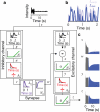Coordinated dynamic encoding in the retina using opposing forms of plasticity
- PMID: 21909086
- PMCID: PMC3359137
- DOI: 10.1038/nn.2906
Coordinated dynamic encoding in the retina using opposing forms of plasticity
Abstract
The range of natural inputs encoded by a neuron often exceeds its dynamic range. To overcome this limitation, neural populations divide their inputs among different cell classes, as with rod and cone photoreceptors, and adapt by shifting their dynamic range. We report that the dynamic behavior of retinal ganglion cells in salamanders, mice and rabbits is divided into two opposing forms of short-term plasticity in different cell classes. One population of cells exhibited sensitization-a persistent elevated sensitivity following a strong stimulus. This newly observed dynamic behavior compensates for the information loss caused by the known process of adaptation occurring in a separate cell population. The two populations divide the dynamic range of inputs, with sensitizing cells encoding weak signals and adapting cells encoding strong signals. In the two populations, the linear, threshold and adaptive properties are linked to preserve responsiveness when stimulus statistics change, with one population maintaining the ability to respond when the other fails.
© 2011 Nature America, Inc. All rights reserved.
Figures






References
-
- Laughlin S. A simple coding procedure enhances a neuron's information capacity. Z Naturforsch, C, Biosci. 1981;36:910–912. - PubMed
-
- DeWeese M, Zador A. Asymmetric dynamics in optimal variance adaptation. Neural Computation. 1998;10:1179–1202.
-
- Fairhall AL, Lewen GD, Bialek W, de Ruyter van Steveninck RR. Efficiency and ambiguity in an adaptive neural code. Nature. 2001;412:787–792. - PubMed
-
- Nagel KI, Doupe AJ. Temporal processing and adaptation in the songbird auditory forebrain. Neuron. 2006;51:845–859. - PubMed
Publication types
MeSH terms
Grants and funding
LinkOut - more resources
Full Text Sources

